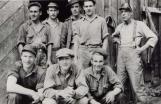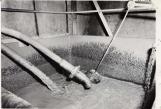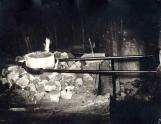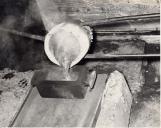7
Mining the gold bearing quartz veins in the area involved many stages. These included sinking shafts, driving tunnels, crosscuts to veins, drifts along veins to sample gold values and stoping ore between levels. Finally, lowering it by chute to level below, tramming to the shaft and hoisting it to the surface for milling. In the following years new engineers arrived and new equipment and methods were used.9
Pipefitters provided compressed air and water for the drills. Ventilation crews provided fresh air for breathing as well as clearing out powder fumes after the blasting. Timbermen took care of the timbering and train crews handled the ore on main haulage levels. There were also hoistmen, surveyors, samplers, skiptenders, electricians, geologists and supervisors rounding out the complex operations of underground mining.10
Mucking Gear used from the early 1940's to 1970's1970
Bralorne-Pioneer Museum Mining Equipment display, Bralorne, B.C
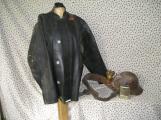
11
In preparation for going underground the shift crew changed to their diggers or work clothes in "the dry", a large room equipped with lockers, showers, and an overhead rope and pulley system for hanging clothes. For illumination underground, the men used the open flame of a carbide lamp clipped to a bracket on their hard hats. Water, controlled by a simple valve, dripped onto the carbide and ignited by flint and wheel, created acetylene gas. The gas burned until all the carbide had reacted,(about 45 minutes) and then had to be filled again. In late 1936 carbide lamps were replaced with electric lamps at both the Bralorne and Pioneer mines. Powered by a wet battery worn on a special heavy leather belt, they produced better light and lasted up to twelve hours between chargings.13
From 1931 to 1961 Bralorne removed most of the gold from the ore by the amalgamation and flotation process. Any remaining gold was obtained by shipping the flotation concentrate to a smelter in Tacoma, Washington. In 1961 the mill was replaced by a modern cyanidation plant and with this process the mine was able to extract all the gold on the property.15
The process of melting the concentrate in graphite crucibles over a fire was used through the 1950's and into the 1960's. The furnace was used a little later until the mine was closed in 1971.17
The melted sponge gold was poured from a crubicle into the gold mold just out of the furnace. The weight of the gold brick after cleaning off the waste materials that formed on the top of the brick was approximately 380 to 386 ounces and measured about 5" by 3" by 9" long.18
In 1959 the two mines amalgamated to form Bralorne-Pioneer Mines Ltd. under the direction of Franc R. Joubin. This move facilitated the development of holdings along their common boundary and the combined working capital provided funds for exploration and expansion. In 1961 the Pioneer workings were closed down due to lack of available ore.19
1971 Day crew of Bralorne Pioneer Mines Ltd. shortly before it's closure.June, 1971
Bralorne Mine, Bralorne, B.C. Canada
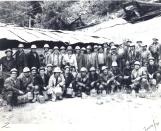
20
By 1965 Joubin disposed of his shares and left the board. Increases in miners' wages, problems with mining at increasing depths and a 25 percent increase in production held the costs of production at just 7 percent of the 1957 figure. The price of gold was stuck at $35.00 U.S. an ounce, no important finds of high grade ore was indicated and outside exploration failed to come up with a new mine to replace Bralorne.Under George Davenport's leadership, the company began to turn away from mining, acquiring interests in gas and oil and incorporated a subsidiary company to manage them. Bralorne continued to operate, hoping that the price of gold would eventually increase. The Queen shaft was sunk a further 373 feet. Development work in 1967 added to the mine's ore reserves with grades at 0.53 ounces per ton. Now the mine was working at the 43 level which proved to be challenging. At this depth the rock temperature was 128 degrees fahrenheit and ventillation had to be increased proving difficult and expensive. Now gold mining was marginal with the cost of production being above the price of gold. In 1967 Can-Fer Mines Ltd. accumulated shares on the open market eventually obtaining 250,000 and in 1968 two of their officers joined the Bralorne Pioneer board. The two companies merged to form Bralorne Can-Fer Resources Limited in 1969, leaving the Bralorne Pioneer shareholders with less than 30 percent interest in the continuing company. The mine operated through 1970 with the Emergency Gold Mining Assistance Act providing $10 for each ounce of gold produced and supplying a modest cash flow. But now Bralorne and Can-Fer was only a salvage operation that would close as soon as gold could not be produced at an acceptable cost. In the Summer of 1971 the Bralorne Mine finally closed and the community dissolved to a fraction of what it once was.
